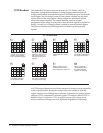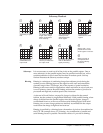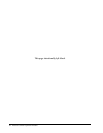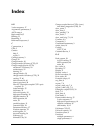
40 Advanced Camera Operation Manual
Dark Current Noise
Dark current, or thermally generated charge, can be measured and subtracted
from data, but its noise component cannot be isolated. Dark current noise is a
particular concern in low-light applications.
To reduce dark current, CCDs can be chilled to approximately –50°C with
thermoelectric cooling. For extremely long exposures, liquid nitrogen is used to
cool the CCD to as low as –120°C. At lower temperatures, CCD performance
may be degraded due to poor charge transfer efficiency.
MPP Operation Multi-pinned-phase (MPP) or inverted operation reduces the rate of dark
current generation by a factor of 20 or more and thus relaxes CCD cooling
requirements to the level where a thermoelectric cooler is sufficient for most
applications.
Most of the dark current in a CCD is generated by interface states at the silicon–
silicon dioxide interface just below the parallel gate structure. In MPP mode, this
dark current component is significantly reduced by biasing all of the parallel
register gates into inversion. However, this causes the potential wells essential
for operation to disappear, allowing charge to spread up and down columns.
Efficient CCD action can be ensured by processing CCDs with a built-in
potential step that restores the potential wells when the parallel gates are biased
at the same voltage. Only CCDs thus processed can be operated in inverted
mode.
Tradeoffs
In a given situation, the available light level determines the integration time
required to arrive at an acceptable SNR. Acceptable SNRs vary with the
application; the tradeoffs between light level and integration time must be
considered for each circumstance.
When the light level is high enough that photon statistics are the dominant
source of noise, preamplifier noise and dark current are not relevant. The CCD
data are said to be photon noise limited. Under low-light conditions, where
preamplifier noise exceeds photon noise, the CCD data are said to be
preamplifier noise limited. When long integration times are used, it is important
to ensure that the noise from dark current does not exceed preamplifier or
photonic noise from the signal.
Two examples give some insight into the tradeoffs required to maximize the
SNR:
• Solar astronomy is a typical high-light-level CCD application. For this
application, it is important to detect small fluctuations in intensity over
the area of the sun as a function of time. Because the light source is very
bright, a slow-scan CCD camera always operates under photon noise
limited conditions.
• Low-light-level conditions, such as those encountered in fluorescence
microscopy, present a different problem. For this application, the
photon flux is typically low and the excitation exposure must be kept
short to avoid bleaching. CCD sensitivity and preamplifier noise are
extremely important. If the CCD has a preamplifier noise of 10 electrons,
the image data are preamplifier noise limited when the number of
photoelectrons in a pixel is less than 100. For signals above 100 electrons,
the data are photon noise limited.


















